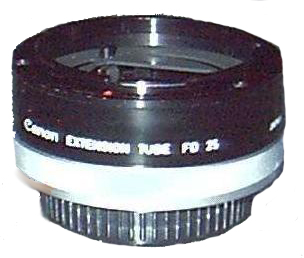An FD to EF Converter
Using your old system lenses of Canon's latest cameras
- Scrap, or sell off the old system, and get all new lenses, and bodies.
- Stick with the old system, and seek out older used lenses and bodies to expand capabilities.
- Find a way to use your old lenses with a new system based on the current bodies.
Adapting the older FD series lenses to work on the newer EF series cameras is not as simple as just changing the mount. As was mentioned in my lens sections, the FD series uses a mount and linkage which is purely mechanical, while the EF series uses a linkage which is purely electronic. Even so, lenses are lenses, and it would seem that there should be a way to mount one style of lens on a different style of camera. To a certain extent, you can, but there are some trade offs.
 I should first mention that, though FD lenses can be made
to function on EF cameras, there is no way to get EF lenses to work on FD
cameras. There was never even an attempt made to produce a converter for
this purpose. One main reason for this is market demand. There were a number
of photographers who were unwilling to abandon their extensive lens systems,
when Canon introduced it's new series of cameras. They wished to avail themselves
of some of the new offerings, but not at the expense of an entire new system
of cameras and lenses. A converter would be just the thing, and was even considered
to be a necessary offering in order to prevent lagging sales of the newly
introduced cameras. On the other side of the coin, there is really little
need for the old FD user to wish to use the EF series of lenses. FD lenses
are plentiful, and less expensive, while being the equal, optically, of the
newer models. In addition, the new
I should first mention that, though FD lenses can be made
to function on EF cameras, there is no way to get EF lenses to work on FD
cameras. There was never even an attempt made to produce a converter for
this purpose. One main reason for this is market demand. There were a number
of photographers who were unwilling to abandon their extensive lens systems,
when Canon introduced it's new series of cameras. They wished to avail themselves
of some of the new offerings, but not at the expense of an entire new system
of cameras and lenses. A converter would be just the thing, and was even considered
to be a necessary offering in order to prevent lagging sales of the newly
introduced cameras. On the other side of the coin, there is really little
need for the old FD user to wish to use the EF series of lenses. FD lenses
are plentiful, and less expensive, while being the equal, optically, of the
newer models. In addition, the new Canon introduced an adapter unit for the EF lenses, at about the same time the lenses themselves were introduced. the unit was to be sold to working pros only, and was offered in limited quantities, for a short period of time. The Canon adapters are now very expensive, on those rare occasions when they might be found. Some after market companies also offered converters (some still do), but all have limitations. The Canon unit is the best, not surprisingly, and permits the use of the lens, in manual focus mode, requiring stopped down metering. Neither of these are serious limitations, particularly for the experienced photographer. The adapter itself was simple in concept. One end had an EF mount, while the other used an FD mount. There were no linkages, since the mechanical FD system, and the electronic EF systems can not really be linked. One thing which did need to be added to the basic metal mount, was a small single element lens. This lens is used to make up for the fact that the converter changes the distance between the film plane, and the FD lens.
Most of the units offered by other manufacturers come with the warning that the adapters will impair the ability of the lens to focus at infinity. They are generally offered as macro adapters. Having purchased, and used one, I found myself pleasantly surprised. The model I tried, retains the infinity focus of the lens, though the focus scale is no longer accurate. It is quite possible, with this unit, to focus "past" infinity. Other than this minor, but irritating quirk, the converter is perfectly satisfactory. Other than the focus issue, the adapter requires all metering to be done in stopped down mode. Since there are no mechanical linkages with the camera, the lens must be set to stop down, before it is installed into the adapter.
| The Photo to the left shows a Canon FD lens with it's stop down lever in the normal position, for full aperture metering. The photo to the right shows the same lens with the lever pushed to it's locking position for manual aperture metering. |